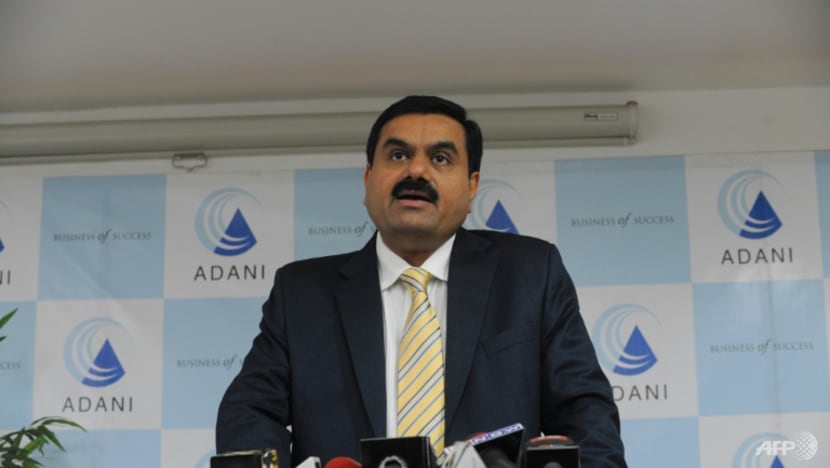Indian Gautam Adani's rise to world's third-richest came as stock jumps topped 1,000%
His Adani Green and Adani Total Gas trade at more than 750 times profit, far higher than Elon Musk’s Tesla or Jeff Bezos’s Amazon.

Indian billionaire Gautam Adani making a bid to buy broadcaster NDTV. (File photo: AFP/Sam Panthaky)
First, he became the richest person in Asia. Then his net worth surpassed those of Warren Buffett and Bill Gates. Now he’s fast approaching a level of wealth only rivalled by Jeff Bezos and Elon Musk.
Gautam Adani’s ascent, by about any measure, has been nothing short of remarkable.
During a year in which many fortunes around the world have crumbled, his net worth has nearly doubled, increasing US$64.8 billion to US$141.4 billion and making him the third-richest person on the planet, according to the Bloomberg Billionaires Index.
His surging fortune is now attracting fresh scrutiny to the valuations of his companies, the leverage embedded throughout his business empire and his ties to India’s government.
His Adani Green Energy and Adani Total Gas trade at more than 750 times profit, while Adani Enterprises and Adani Transmission have valuations north of 400 times.
By comparison, Musk’s Tesla and Bezos’s Amazon.com have price-to-earnings ratios of about 100, while fellow Indian billionaire Mukesh Ambani’s Reliance Industries trades at 28 times.
Adani, 60, has shifted his conglomerate’s focus in line with what Prime Minister Narendra Modi deems crucial to meeting India’s long-term economic goals.
He has done that in part through a debt-fuelled expansion that led Fitch Group unit CreditSights to call his empire “deeply overleveraged” in a report last month.
“Adani has built up an extraordinary fortune through a mix of aggressive risk-taking, rapid debt accumulation and canny political connections,” said James Crabtree, author of The Billionaire Raj, a book about India’s wealthy and inequality.
“His rapid rise over barely a decade to the summit of India and Asia’s tycoon class represents the possibilities and rampant inequality of India’s new Gilded Age.”
A representative for the Adani Group declined to comment for this story.
Adani, a college dropout who was held for ransom and survived a terror attack, tried his luck in Mumbai’s diamond industry in the early 1980s before turning to coal and ports.
He went on to build a business empire spanning everything from airports to data centres, media and cement. Last year, he vowed to invest US$70 billion in green energy to become the world’s largest renewable energy producer.
Judging by the stock market, Adani’s moves have been wildly successful.
Shares in some of his companies have climbed more than 1,000 per cent since 2020. That compares with a 44 per cent advance for the nation’s benchmark S&P BSE Sensex Index.
Adani Group shares climbed on Tuesday (Sep 6), with Adani Total Gas and Adani Enterprises up more than 2 per cent.
The sharp gains, particularly as global financial markets waver in the face of higher interest rates, have added to existing worries over opaque shareholder structures and a lack of analyst coverage. By contrast, the dollar bonds for many of the group’s companies have tumbled.
“You don’t know how his market is rising so sharply because there doesn’t seem to be much institutional investor interest,” said Hemindra Hazari, an independent research analyst based in Mumbai.
The CreditSights analysts who warned about the excessive debt levels of Adani’s firms said the founders, known as “promoters” in India, need to inject more equity capital into the companies to reduce leverage on their balance sheets.
They also expressed concern that entering new, unrelated businesses that are capital intensive raises its own set of risks.
The Adani Group responded by saying it has improved its debt metrics over the past decade, with the leverage ratios of its portfolio companies now “healthy” and in line with their respective industries.
Net debt has dropped to 3.2 times earnings before interest, taxes, depreciation and amortisation from 7.6 times in 2013, the group said.
At the same time, stakes pledged for loans have slid from highs in 2020, when a COVID-fuelled stock rout pushed Adani and his family to increase collateral.
Despite the skepticism, CreditSights said it drew “comfort” from the group’s strong relationships with banks as well as the administration of Modi, who won re-election in 2019 with almost two-thirds of the votes.
Sharon Chen, a Bloomberg Intelligence analyst who covers Adani’s ports and utilities units, said she is not concerned by the level of leverage and does not expect any funding issues.
“He’s not only on an acquisition spree and banks are willing to fund him,” but he has close ties to Modi, Hazari said. “As long as this government lasts - and it is expected to last quite a long time - the music will continue.”














